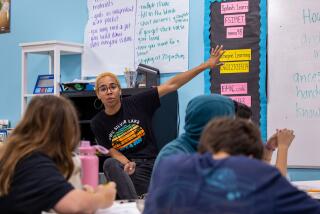SANTA ANA : Science Program Is a Fun Experiment
Jackie Gonzalez, 6, knows how quickly money can slip through a person’s fingers. But she didn’t learn that at the store. She learned it in science class.
During a recent school experiment, Jackie, a first-grader at Martin A. Heninger Elementary, discovered that a dollar bill falls so quickly that most people can’t catch it between their thumbs and index fingers, even when it’s released just above their hands.
Although she enjoyed the experiment, Jackie said she was more impressed with the opportunity to conduct it inside a high school classroom, with older students as her teachers.
As part of a test program designed to spur greater interest in science among elementary school students, Jackie and hundreds of kindergarten and first- and second-grade students at Heninger attend classes at Santa Ana High School, which is just down the street from their campus.
During the classes, high school students guide the youngsters through lab experiments. Recent topics have included circulation and blood pressure, for which students examined the tails of live goldfish under microscopes to see blood coursing through the capillaries. They also learned how to take a pulse.
The program is now in its second week. In May and June, third-, fourth- and fifth-grade students from Heninger will replace their younger counterparts.
Teachers at both schools call the program a success and said it will continue next year. The program is popular with students from both schools as well.
“We’re proud to teach them,” said sophomore Roberto Mejia, 19. “I like it.”
Dwarfed by stools and laboratory tables made for adults, the Heninger students watched wide-eyed during one class as Santa Ana High science teacher Jim Browning began the reaction time demonstration with his students.
For the exercise, a student placed his hand on a countertop, holding his thumb and index finger about an inch apart. Browning, holding a ruler above the gap between the student’s fingers, told the children that they could see how quickly a person reacts by measuring how far the ruler drops before it is caught.
Browning released the ruler, which fell 30 centimeters before the student pinched his fingers together and halted its fall.
“If you can catch 15 centimeters on the ruler, you can catch my dollar,” Browning told the class, switching the ruler for cash.
On his attempt, Francisco Magallon, 14, a freshman, reacted too slowly and the dollar slipped through to the floor.
“You gotta get faster,” Browning said as the students giggled.
He said later that the program prompts the older students to pay closer attention. “They would have to focus more because otherwise how could they teach someone else?”
Jackie Campbell, the Heninger science teacher who coordinates the program, said her students can hardly wait for the next class. They ask, “ ‘Do we have science today? When do we have science?’ They have been so motivated to do these activities,” Campbell said.
Said Heninger student Jackie Gonzalez: “Every school should have a science lab like this one.”
More to Read
Sign up for Essential California
The most important California stories and recommendations in your inbox every morning.
You may occasionally receive promotional content from the Los Angeles Times.










